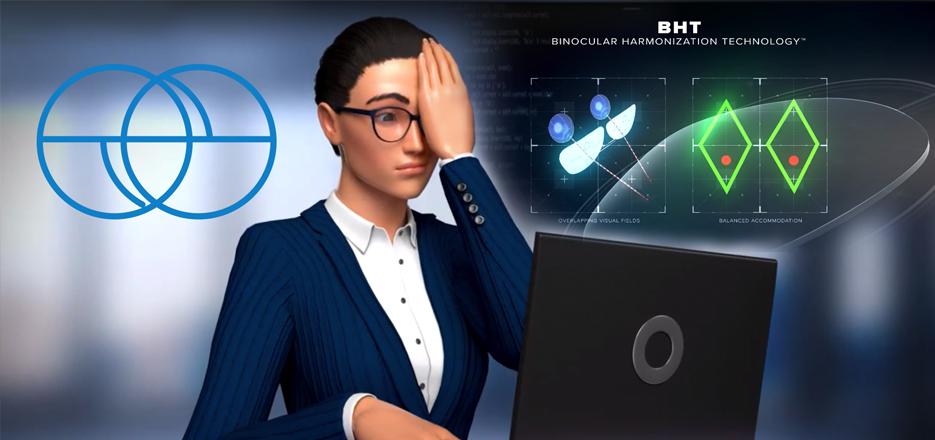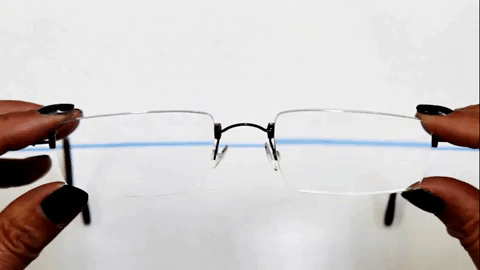Dr. Nathan Bonilla-Warford queried the “VT-OD” list-serve this morning, asking if anyone had experience with Hoya’s new progressive lenses in practice. Nate wanted help in separating the wheat from the chaff. We’ve addressed this subject before about theory versus practice, and promise versus delivery with various proprietary lens types. I don’t have any personal experience with Hoya’s technology, but let’s take a look at the links Nate supplied.
The first was an article that Hoya sponsored in Review of Optometric Business last week titled: “The Next-Generation Progressive Addition Lenses (PAL) with 3D Binocular Vision™ Technology Poised to Change the Patient Experience”. In a nutshell, it claims to optimize the balance between the two lenses by taking anisometropia into account, minimizing induced binocular challenges vertically as well as horizontally. The two proprietary modalities it touts are 1) A Binocular Eye Model and 2) Binocular Harmonization Technology. Quoting from the article:

“HOYA applies a Binocular Eye Model that uses ray tracing technology to create real-life scenarios for both eyes. The Binocular Eye Model considers all elements that are important for enhanced binocular performance of progressive lenses, and includes the patented Binocular Clearness Index, Binocular Accommodation Demand Difference, Binocular Vertical Prismatic Difference, Binocular Convergence and the Binocular Magnification Difference. These unique evaluation methods guarantee that each design is verified under real-life circumstances before it goes into production, and ensure unprecedented binocular performance of the lenses, regardless of the prescription difference of both eyes.”
“HOYA’s Binocular Harmonization Technology (BHT) considers the prescription for the right and left eyes as individual components to calculate the optimal binocular lens design, ensuring that the power distribution and progressive corridor of each lens is exact according to the needs of each eye. This results in perfect and effortless focusing, constant stability and excellent depth of vision.”
Binocular Harmonization Technology (BHT) is the subject of the second link that that Dr. Bonilla-Warford supplied, though it doesn’t add much further insight to the above. Interestingly it shows a simulation of asymmetrical vertical image displacement of a line in an anisometropic pair of lenses (more plus OS than OD) that doesn’t incorporate BHT. It would be a nice touch if they did a comparison showing how the BHT offsets that effect.

Intrigued by the concept, I googled further and found a white paper that Hoya produced on BHT and their Binocular Eye Model. Read it, and you’ll get a better feel for what the technology is trying to accomplish.
Beyond the promo material which the company puts out, I came across this blog written by an independent optician, with what the optics looks like diagrammatically, who speaks favorably of its performance.

In any event, as I said at the outset, I have no personal experience with this type of lens. But as Nate, I’d be intrigued to hear from any of you who have – particularly if you can speak to the accommodative and binocular issues the company purports to address. The design certainly does sound promising for patients desiring PALs who have a moderate amount of anisometropia.
ADDENDUM
Just near the midnight hour, Peter Shaw of Shaw Lens posted the following to the VT-OD list:
“HOYA have had this on the market for about 5 years or so now. I have “reversed engineered’ what they are doing and it appears that they use equal or nearly equal base curves and some adjustment to corridor length. They are a little opaque about what they do exactly but they do not claim that they are Iseikonic or isophoric. HOYA have excellent technology and I am delighted to have another industry enterprise pay attention to binocular disorders.
Being quite adept at lens design myself, I programmed our design engine to mimic various lens design. It was quite a bit of work to do the math of HOYA’s unusual PAL platform wherein the front surface is atoric in the lower zone but I succeeded and now have an engine where I can create a virtual, freeform, compensated lens of absolutely any design. You can’t hide from geometrical optics.
Anyway, through the powers of Bill Gates and the folks at IBM that created this amazing thing called a PC here are some graphics that I think are self explanatory. Please excuse the plug for SHAW lens but my usual disclaimer that I am the dude that invented the method that produces SHAW Lens.
In summary, the BHT is a little better than an ordinary freeform PAL but does not have the performance of a true isophoric/iseikonic design such as a SHAW design. Check out the graphics. Ask me any questions. I have included 2 representative Rx with anisometropia.”

